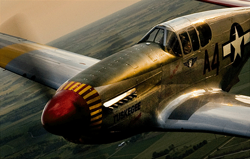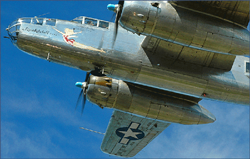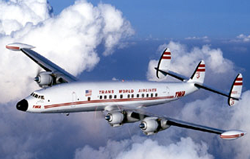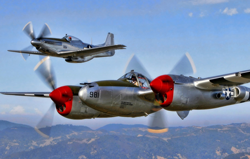Mitchell

Manufacturer: North American Aviation
Primary Role: Medium Bomber
- Description:
- Specifications:
The original design for the B-25 Mitchell medium bombers was drafted with Britain and France as the intended customers, but they opted for A-20 Havoc bombers from Douglas Aircraft Company instead. In 1939, the United States Army Air Corps evaluated the design and was satisfied with the prototype aircraft's performance. The original prototype, code named NA-40B, crashed on 11 Apr 1939, but the US Army liked the little they had observed thus far, and decided to order the design into production without further testing. Out of the modified design, now named NA-62, the production B-25 Mitchell bombers were born. Some of the changes with NA-62 include a new wing shape and a larger tail fin. The first B-25 bombers entered service with the US Army in 1940.
Among their early missions was the Doolittle Raid in Apr 1942, where United States Navy aircraft carrier USS Hornet steamed close to Japan and launched US Army B-25 Mitchell bombers on an attack on Japanese cities; it was meant to be an attack at the Japanese morale and at the same time a morale booster for the Americans. Headed by Lieutenant Colonel James Doolittle, 16 lightly armed B-25 Mitchell bombers took off at the dawn of 18 Apr 1942 and bombed Tokyo and other cities. Actual damage inflicted was minimal, and 15 out of the 16 were destroyed in crash-landings in China after the mission, but the boost of American morale was significant. The lone B-25 bomber that survived the mission landed in Russia, and the aircraft was confiscated by the Soviets.
In the Pacific War, B-25 Mitchell bombers were frequently used at low altitude, acting as ground attack aircraft instead of as medium bombers. These strafing aircraft were first devised in the field by the likes of Major Paul Irving "Pappy" Gunn, who initially modified A-20 Havoc bombers but later also submitted requests to perform similar modifications to B-25 bombers by adding guns and eliminating any unnecessary weight and space; as his request was approved by George Kenney, Kenney would also claim design credit, noting that he had further contributed to Gunn's designs. The resulting B-25G aircraft each had additional machine guns and a 75mm M4 cannon, the largest caliber weapon ever equipped in an American bomber. A later variant, B-25J, increased the number of machine guns to 18. Finally, B-25 bombers sometimes served as troop transports in the South Pacific.
Although B-25 bombers were noisy and caused hearing problems for the pilots and crew after the war, they were were well loved by their crew for that they could absorb significant amounts of damage and still maintain manageable flight characteristics.
9,984 were built between 1941 and 1945; 6,608 of them were built at North American's Fairfax Airport plant in Kansas City, Kansas, United States.
Length: 9.99 m
Height: 4.80 m
Powerplant: Two Wright R-2600 radial engines rated at 1,850hp each
Cruising Speed: 370 km/h
Maximum Speed: 442 km/h



